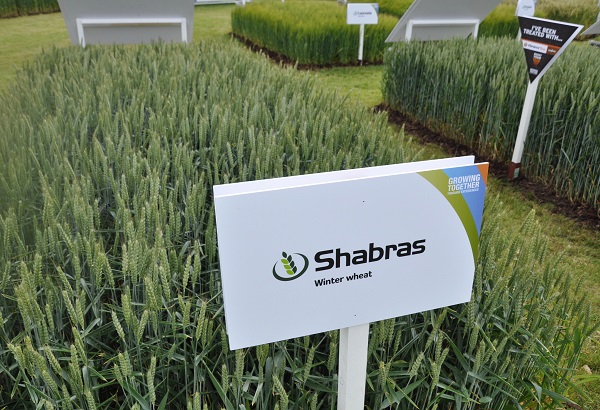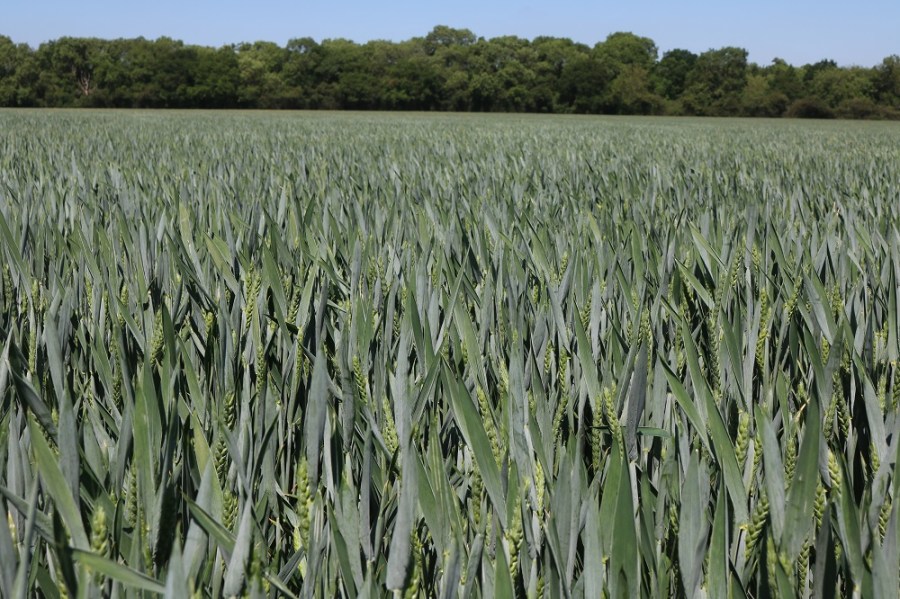Everyone loves consistency and reliability and when it comes to wheat varieties, it’s no different, so could Syngenta’s Group 4 feed wheat Shabras be an ideal choice? CPM investigates.
It’s a promising prospect for growers as there’s no compromise with agronomy.
By Melanie Jenkins
Nestling itself firmly near the top of the hard Group 4 feed wheats on the AHDB Recommended List for winter wheat, Shabras is a high yielding wheat with a strong disease package. What’s more, its scores indicate it can perform up and down the country and across soil types.
The variety first appeared on the RL in Dec 2016 for the 2017 season, as a high yielding, hard-endosperm Group 4 feed wheat. “It had shown such good consistency across all regions, from eastern, northern and southern areas of England,” says Samantha Brooke, seed and seed treatment manager at Syngenta. “It yields 104% of control across the whole of the UK and between 104% and 105% in all regions, meaning it has consistency and flexibility for growers.”

At 6.2 for septoria and an 8 for yellow rust, its RL disease scores put Shabras in good shape ahead of its nearest yield rival, although there’s only a 4 for brown rust.
The variety had a lot of support last season as it’s a very sound feed wheat, says James Barlow, technical sales at Gleadell. “Shabras’ yield is still up there, just a couple of percentage points behind the leaders of the Group 4s and has a good untreated yield. Regionally it took our eye as it’s very consistent across all regions and trial years.”
As a new variety, it was of most interest to Chris Piggott, regional seed manager at Frontier, because it was one of the highest yielding varieties, with early maturity. “It was the only variety with both last year. With pressures on rotations and blackgrass, having these two traits means it’s a promising prospect for growers as there’s no compromise with agronomy. At one of our trial sites last year, it was the third highest yielding variety – so the earliness hadn’t compromised the yield. It’s performed best on light land, but over all soil types its performance has been positive.”
The consistency of Shabras also stood out to Chris. “We like consistent varieties and it’s only had a 1% swing in yield over the past four years.”
Shabras shone in trials, having a high yield potential and showing consistency across the board. Syngenta picked up on its potential the year before it went into National List trials, where it really impressed Samantha by how different it was to other varieties in the trial plots. “It stood out and presented itself with a different growth habit and because it substantially out-yielded other varieties.”
Shabras was bred through Syngenta’s doubled haploid breeding programme – the quickest way to get a cross to market, explains Samantha. “It’s a cross of Cassius and Hereford: Cassius is a soft endosperm, but Hereford is a hard, while both had the potential for high yields. Hereford is also a fantastic second wheat – head and shoulders above others – and both bring in strong Septoria tritici resistance.”
Though it’s often yield that catches an eye, it’s become the case for a number of farmers that septoria resistance is increasingly the most important factor when selecting a variety. “One of Shabras’ plus points is its Septoria resistance,” says Samantha. “At 6.2 on the RL it’s in good shape ahead of its nearest yield rival.”
Shabras’ other disease scores also help it stack up. “It has an 8 for yellow rust – which is always nice to see,” says Samantha. “Brown rust is the weakest score, so do watch out for it. However, if kept an eye on that’s a disease that’s easy to control.”
Though its brown rust score is lower, at a 4, and people think it could be susceptible, the levels of infection in trials have been less than expected, explains Chris. “It has performed more like it scored a 5 or a 6 – so better than its actual score would suggest.”
It has very good septoria and yellow rust scores, agrees James. “These are two of the biggest yield robbers. The septoria resistance is a key reason why growers might choose to grow it. It’s helped that AHDB changed the scoring to one decimal place, particularly for western growers who might look at septoria resistance before yield.”
Shabras suits a late drilling spot and can handle increased seed rates. “If drilling late, increase the seed rate,” advises Samantha. “Seed rate will depend on timings but from 275 seeds per m² to 375 seeds per m².”
The growth habit of Shabras is likely to make it stand out in any plot. “It has a quite different growth habit to other varieties,” says Samantha. Sown from late Sept onwards, it has a very quick spring regrowth. “It has quite an erect growth habit and stands up a lot more than others, looking quite different in spring,” she adds. It’s a big eared variety with fewer tillers.
Even though it can be drilled late, it matures early, explains Samantha. “As a 0 it’s equal to JB Diego, so you have a high yield mixed with early maturity.” Shabras would fit well as a stable mate for other high yielding varieties to offer flexibility to growers as well as spreading the risk.
James agrees that Shabras’ early maturity means it can complement other feed varieties, giving growers a nice early start into harvest. “It also has nice stiff straw and isn’t too tall.”
It fits very well into a second wheat position, says Chris. “Growers can be concerned when the eyespot score isn’t the highest, but to get the best out of it will be as a second wheat on lighter land. However, it does well as first wheat and I wouldn’t want to pigeonhole it.”
But with such a solid appearing all-rounder, is there anything growers need to be cautious about? Midge resistance is the one area that some are flagging up as Shabras shortfall. “Midge resistance is the only thing it hasn’t got,” says James. “Syngenta also released Gleam which is on the RL this year which has resistance, so growers have other options.
“We’ve not had a bad midge year for a while but that isn’t to say one couldn’t spring up out of the blue,” he warns, although adding that growers don’t need to overreact to its lack of midge resistance.
It’s a shame that it doesn’t have midge resistance, agrees Chris. “Without effective control on midge there is a need to think about resistance in varieties, as if we have a bad year it would be very damaging.”
Being a big eared variety means it has good grain quality, with specific weights and low screenings. “On paper, a good sample of Shabras could be upgraded and there’d be no reason a miller wouldn’t take it. But this is only a bonus if the sample is good,” says James. “I’d still advise farmers to grow it as a feed wheat and then sample.”
As a high yielding and easy to manage variety, it should end up with about 3.5% market share this year, suggests Samantha. “It has the potential to get up to 4%, which is fairly good and I’d certainly be pleased with that.”
However, it does have a lot of competition, notably Syngenta’s Gleam, says James. “It has similar septoria and disease scores, while Gleam has the benefit of midge resistance, but I can see Gleam and Shabras partnering each other nicely on farm. I can’t see any reason why it’s market share would drop off though.”
The only thing is if newer varieties bring more to the table in terms of yield and resistance, says Chris. “But it still holds its own in both camps. The rounded view is that it’s fairly new to us, but we’ve seen it in trials for a number of years and if it does well on farm this year, it should do well in terms of seed sales.
There’s no reason to say it won’t be a big variety over the next year, says James. Farmer feedback has highlighted that Shabras “does what it says on the tin” – it’s a nice clean wheat. “Growers who’ve had it in the ground and have got on well with it won’t have a huge incentive to change from it.”
High output and first past the post makes Shabras user-friendly
High yields even in a difficult growing season from a variety that was easy to manage and allowed plenty of time for stale seedbeds. Added to this, it’s early maturing and suited to later drilling.
Those have been the standout benefits seen for new winter wheat variety Shabras by Beds and Herts grower Peter Allen of P and D Allen (Farms), based near Biggleswade.
Farming up to 1200ha a year – comprising 730ha on the home farm and the rest contract-farmed – on soils ranging from clay, to chalk, to sand, to gravel, he’s grown just over 80ha of Shabras for seed each year over the past two years. Growing it back-to-back in the same fields means he’s experienced it as a first cereal and now as a second wheat, over two different winters.
Despite last season’s dry spring, Shabras still delivered 10+ t/ha on heavy land and 9t/ha on medium soil, using just a standard fertiliser programme, he reports. That compares with the business’ typical yields of between 7.5-10t/ha, depending on each year’s rainfall, sunshine hours and the soil type of the block of land in question.
However, it was its combination of yield with early maturity that was most notable – with the variety harvested at the start of Aug.
“For a lot of varieties to produce high yields, you’re getting that from later maturity,” says Peter. “The advantage with Shabras is that it’s high-yielding yet also early maturing.
“Usually, if we’re harvesting on 1 Aug, it’s on lighter land where crops have burnt off. But this was on heavier and medium land. It was the first of our wheats to be cut, so there was a bigger window for blackgrass control.
“All the fields stood at harvest, and it didn’t create any disease problems outside what we’d normally spray for,” he adds.
Despite last season being a low one for specific weights, with the dry weather arriving at just the wrong time, Peter says Shabras still gave the best specific weights of any wheat on the farm. “It combined very nicely – it was easy to get a nice sample and the heads threshed well.”
This season, with drilling of Shabras in the same fields purposefully delayed until the end of Oct for blackgrass management, it’s allowed nearly a full three months for field work and stale seedbeds.
Shallow cultivations down to just 10mm were used to avoid bringing buried blackgrass seeds back to the surface, with emerged blackgrass sprayed off in stale seedbeds before establishing with a direct drill. Even with late drilling, he says this year’s Shabras looks good.
Shabras at a glance





